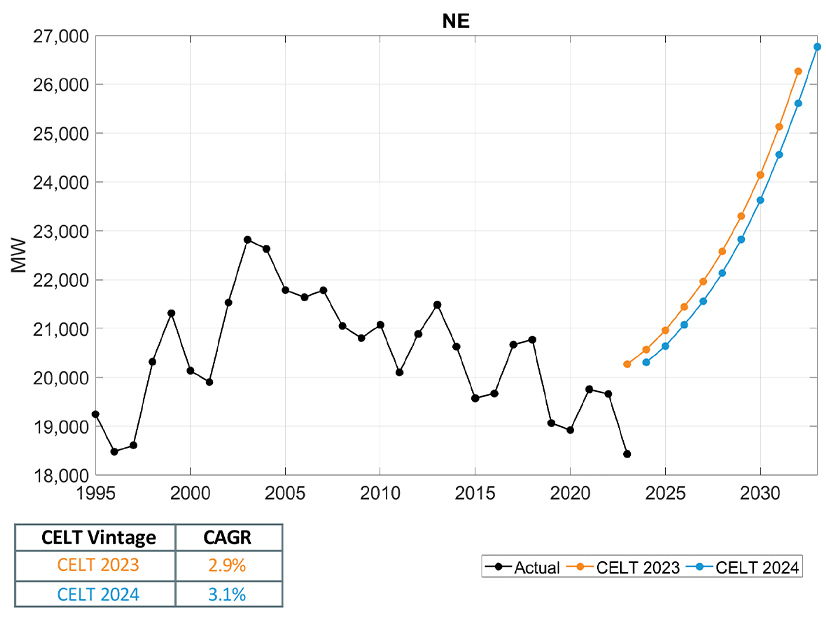ISO-NE is decreasing its peak load projections slightly for the next 10 years due to slower-than-expected electric vehicle adoption, managed charging programs and changes to its modeling of partial building electrification.
The RTO projects a 2033 net winter peak of 26,768 MW and a net summer peak of 27,052, it told stakeholders at the NEPOOL Reliability Committee (RC) on April 17. ISO-NE reduced its 2032 projections by 1.8% for the net summer peak and 2.5% for the net winter peak.
The net peak projections include demand reductions associated with energy efficiency and distributed behind-the-meter (BTM) resources. The results will be included in ISO-NE’s 2024 Capacity, Energy, Loads and Transmission report.
Both net peak demand and overall net energy have declined significantly in New England over the past two decades due to efficiency efforts and the proliferation of BTM solar. But as the New England states aim to electrify large parts of their transportation and heating sectors, ISO-NE projects load growth to accelerate in the latter part of this decade.
While the New England grid currently reaches its annual peak loads in the summer, ISO-NE anticipates electrification eventually will cause the region’s winter peaks to surpass summer peaks.
“Beyond the forecast horizon, by the mid-2030s, electrification is expected to cause winter peak demand to become the typical, prevailing peak season,” said Victoria Rojo of ISO-NE.
The increase in the winter peak could be partly mitigated by the warming climate, which is causing milder winter weather in New England — 2023 was the warmest winter on record for the Northeast according to data from the National Oceanic and Atmospheric Administration.
ISO-NE’s load projections are based on weather data from the past 30 years and do not consider climate forecasts. Rojo said the RTO hopes to update its methodology to include climate projections in the 2025, 10-year load forecast.
Distributed Energy Resource Data Collection
ISO-NE also proposed a new process to “formalize and standardize the data collection of size, location and characteristics of distributed energy resources.”
The proposal would make distribution providers responsible for providing ISO-NE with data about individual DER installations, including size, fuel type, in-service date and location. The RTO currently collects DER data through voluntary disclosures from distribution providers.
Improved DER data collection would bring a range of benefits for the region, ISO-NE said.
“More accurate forecasts and historical accounting lead to more efficient market outcomes and less uncertainty in system operations and planning,” said Dan Schwarting of ISO-NE.
Schwarting added that improved DER data would lead to “more accurate interconnection studies and more efficient/faster study timelines for FERC– and state-jurisdictional generation projects to interconnect to the transmission system.”
ISO-NE also intends to develop a database collecting DER data so it can better access and use the data, Schwarting said. The RTO plans to present the RC with a draft procedure in May and aims for a vote in June.



